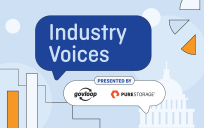The nature of government work often requires employees to wade through a swamp of legacy systems and antiquated processes. On that journey, data gets left behind – because information can’t be extracted.
The good news is there is a fix. Many government agencies are considering cloud technologies, which remove the need for on-premise data storage that creates silos by geography, technology or location. Instead, insights in cloud are accessible, meaningful and collaborative.
Cloud brings the power of hyperscale compute, which can mesh with systems of any size, and its adaptable access controls ensure data only flows to the right people. The benefits stretch further – agencies can easily bring in emerging technology, analytics and front-facing capabilities that can all be contained on the cloud.
Clouds can also integrate with other clouds and on-premise data centers. Therefore, even different environments can marry data analytics and employees. When people and systems can work as a team, as opposed to in isolation, data is more centralized, accessible and consistent.
Don’t just take our word for it. The many benefits of cloud have fueled the federal government’s push for its adoption across agencies, first in 2011 with Cloud First and most recently with the Cloud Smart initiative.
Cloud Smart identifies three pillars to successful transitions: security, procurement and workforce. This points to the fact that effective cloud transitions go beyond the technology itself, which we’ll discuss more later.
Additionally, the President’s Management Agenda highlighted being data-driven as a cross-agency priority, instructing agencies on the importance of “leveraging data as a strategic asset.” Cloud is a great way to hold data to this standard.
Recently, agencies have increasingly gone to cloud email and collaboration services, and over 70% of the largest federal agencies’ mailboxes have moved to the cloud, reducing the impact on federal data centers. A President’s Management Agenda update also notes that security has improved because of standardization.
The insights gained by analyzing data in the cloud apply to entire agencies – and further. The result is a centralized data and analytics base from which agencies can make the most informed and accurate decisions in real time. That means catching terrorist threats quicker or having more knowledge inside emergency rooms.
Cloud sounds like an elixir, but it’s not a magic fix. Learn about the solutions and best practices needed to be effective and data-driven in the cloud here.
This article is part of GovLoop’s recent course created in partnership with Snowflake, “Turning an Avalanche of Data Into Insightful Analytics.” Access the full course here.





Sounds like the coming decade is going to be defined by data—I’m excited!